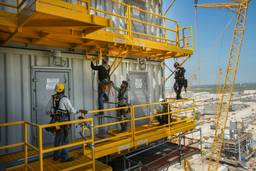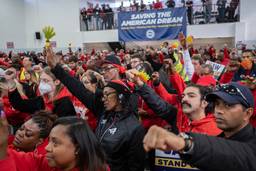The UPS Strike Looms as Corporate America Cashes In
The backdrop of what could be the largest strike at a single employer in decades is that CEOs and corporate America are making record profits as unions—from actors to Teamsters to hotel workers—fight back and flex their power this summer.
Stephen Franklin
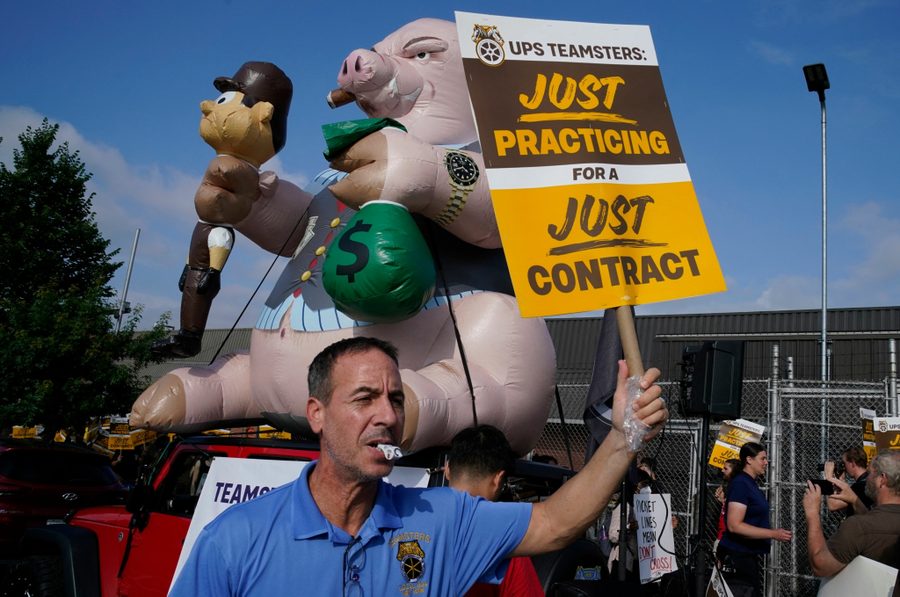
It’s early in the morning and Cesar Mendoza slips into his 20-year-old clunker of a car and heads for the UPS warehouse in Southern California when the thoughts swell up.
Damn, I am stuck here, he thinks. I’m still working only a few hours a day and barely earning anything. And then, he reminds himself, as he does each morning, to try and think positively.
But he can’t.
Six years after starting out as a part-time UPS warehouse worker, he gets $17.85 an hour and when the hours are low, as they’ve been lately, he takes home about $300 a week. With so little money, he, his partner, and their two-year-old son, Lorenzo, are stuck living at her family’s home.
He is also stuck unloading packages, some weighing about 100 pounds, on a belt that he thinks his bosses speed up every so often. With seniority at the warehouse, he asks his bosses to put him on an easier job, but they don’t, telling him, he says, to stay where he is because he’s a hard worker.
“If there’s a strike, I’m willing to take it because we need to be heard and recognized. I just want to be recognized for the work I do,” says the soft-spoken 26-year-old who works at the Gardena UPS hub just south of Los Angeles.
Magnifying the lament of Mendoza and other part-timers to a battle cry, talks for a new five-year contract between the Teamsters and UPS came to a screeching halt on July 5, the most recent deadline set by the Teamsters for UPS to make a deal. Now that the July 5 deadline has passed, the prospect of the Teamsters’ 340,000 UPS members striking when their contract ends on July 31 is significantly higher.
“The truth is @UPS’s negotiators know exactly what needs to happen. They know exactly what our members have earned after putting in years of backbreaking hard work and sacrificing the health of their families so that UPS could fatten its profit margins,” the Teamsters tweeted on July 12.
“The question is: will the company do something about it, or will it force Teamsters to #strike? Only UPS can answer that question,” the tweet thread continued.
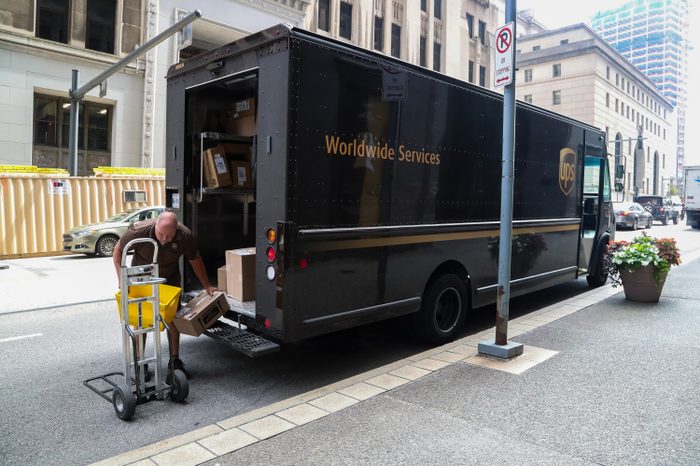
The Teamsters had said that UPS needed to return to the negotiating table. For their part, UPS, claimed the union was “refusing to negotiate.”
But on Wednesday, July 19, the Teamsters announced that negotiations would continue the week of July 24. UPS also confirmed the news to In These Times.
“As thousands of UPS Teamsters practice picket, rally and mobilize around the country, UPS bowed today to the overwhelming show of Teamster unity and reached out to the union to resume negotiations,” according to a news release from the Teamsters. “The Teamsters National Negotiating Committee and the company will set dates soon to resume negotiations next week.”
But how the contract dance between the two sides will ultimately play out is anyone’s guess.
As Alexandra Bradbury and Luis Feliz Leon reported earlier this week in Labor Notes, “Bloomberg estimates a strike would cost UPS $170 million a day. Competitors could only absorb a fraction of its 20 million daily packages. And the 3,300 UPS pilots, represented by an independent union, have pledged they will not cross Teamster strike lines.” The pilots honored the Teamsters’ picket lines in 1997.
The article also notes that “the profound seriousness of the strike threat, light-years from the dynamic in 2018 bargaining, is why the Teamsters have won so much already. And if they reach a deal by the deadline, this will be the reason why — that UPS knew, Wall Street knew, the workers knew, everybody knew how very ready they were to walk.”
Similarly echoing the dangers of a strike, Satish Jindel, a veteran industry expert, says it’s in the best interest of both the Teamsters and UPS to settle sooner rather than later. This is, in part, because if UPS starts losing customers, it hurts both parties.
Dean Maciuba, another industry analyst and former FedEx official, expects bargaining to get tough in the build-up to the strike deadline.
“Yes, they (UPS) made a bundle of money, but it is different now,” says Maciuba, referring to the business UPS gained during the pandemic. The “pricing power that UPS and FedEx had is gone. They can’t indiscriminately raise rates,” he adds.
UPS is now in a tough spot, having already agreed in negotiations to costly changes such as doing away with a two-tier wage system for drivers, says Maciuba.
As a result, he predicts that UPS will seek to hold the line on expenses. That could mean, he says, pushing back on workers’ wages or trimming health care costs. Full-time drivers and part-time workers now get premium health insurance, a rarity among U.S. corporations.
Yet despite the previously collapsed talks, Teamsters’ practice picketing, and UPS’ announcement that it is training non-union staff in case of a strike, Alan Amling, a former UPS official now at the Univ. of Tennessee, Knoxville, says a last-minute deal is possible.
“At the end of the day they realize the lasting damage that would happen to both organizations,” he says.
If the Teamsters strike, it appears that it would be the second or third largest strike at single employer in U.S. history, and the consequences for the U.S. economy could also be broad. But the reverberations of these negotiations and of any strike are also deeply impactful and are very much linked to the various and wide-ranging struggles taking place today between labor and corporate America.
Hearing Teamsters General President Sean O’Brien rail on about UPS’ need to share the wealth with workers or Fran Drescher, president of SAG-AFTRA, complain about the movie industry’s greed, or Shawn Fain, the new president of the UAW, vow to change the “narrative” set by auto companies, may sound like so much rhetoric. But a Facebook post from United All Workers for Democracy (UAWD), the reform slate behind Fain’s rise with UAW, pointed to the bond many see among unions today. It came last week as talks between the UAW and automakers began:
“Across the United States workers are standing up for their fair share in the job sites. From writers to actors, UPS to the Big 3, and many more. The best part? They’re all standing in solidarity and supporting each other. Solidarity is how we will beat the corporate elite.”
This demand for a piece of the pie from a slew of unions and others struggling to bring union cards to baristas, warehouse workers and others is backed up by financial facts and decades of skirmishes between workers and companies.
Workers’ share of the American pie or national income, a number counted by various measures, has “declined substantially in recent years.” The reasons vary. Globalization, automation, tax changes that benefit corporations, corporate greed, low wages, and ultimately the decline of unions. Increasingly hobbled in the past few decades, organized labor has sometimes had to embrace two-tier wages and companies’ greater embrace of part-time work.
As a result of companies’ resistance and other workplace changes, unions’ share of private industry jobs in the U.S. dropped to 6% in 2022.
One example of a major setback for unions was when the UAW accepted two-tier wages in 2007 from automakers pleading difficult times. Another was in the Teamsters last contract in 2018, when the union agreed to a new tier of jobs for drivers for a Tuesday to Saturday shift that pays about 13% less than other full-time workers. Workers had rejected the contract, furious over the wage cut. But union officials, led by former General President James P. Hoffa, invoked an obscure rule and agreed to the contract.
Labor’s backpedaling has coincided with a steep decline in strikes from the 1980s onward. The rationale was simple. A strike had often become a self-inflicted wound. Not only were companies far more willing to call on strike breakers, but they were often winning the battles. The UAW’s six and half years of running strikes in the 1990s against Caterpillar Inc., for example, was largely a loss for the union.
Meanwhile corporate America has been cashing in.
UPS’ stock, for example, was up 58% this month compared to three years ago. The company earlier this year also boasted to investors that dividends have grown for the last 14 years but took off in the last two years; that its revenue hit $100.3 billion in 2022, up $3.1 billion in a single year, and that its adjusted operating margin grew to 13.8% last year.
Companies in the S&P 500 index scored a net profit margin of 12.18% in 2021, a higher number than any ever recorded. CEOs at the nation’s top companies saw a 17.1% increase in their compensation that year, according to the Associated Press. At the same, workers’ wages dropped by 2.4% percent over the previous year after adjusting for inflation, the AFL-CIO reported.
Overall, by one measure (which was a headline in Truthout), “CEO pay has skyrocketed 1,460% since 1978, as Workers’ Wages Stagnate” and in 1980, the average compensation for CEOs of the top 350 companies was 36 times that of the average amount earned by workers. By 2021 that number had ballooned to 399.
At UPS, the CEO to worker compensation gap has also continued to grow. In 2019, UPS’ CEO’s total compensation was $15 million or about 272 times what the average UPS worker earned. In 2022, UPS’ CEO, Carol Tomé’s total compensation was $18.9 million, or 364 times what the average UPS worker received.
The astounding pay disparities exist across industries.
Both the actors and writers unions have publicly criticized Robert Iger, who retired and then later returned as the CEO of the Walt Disney Co. Iger, who has called the unions’ efforts unrealistic, earned $65.5 million in 2018, which was 1,424 times the median compensation of a Disney employee. Amid financial problems for the company, his compensation fell to $15 million in 2022 as compared to the median of $54,256 for Disney workers.
At General Motors, CEO Mary T. Barra’s total compensation in 2022 was around $29 million as compared to a median employee’s $80,034. That’s some 362 times the median for GM workers.
And in Los Angeles, where Unite Here Local 11 is waging a contract struggle with dozens of hotels, one of those companies involved is Hilton, a corporate global giant. Its CEO Christopher J. Nassetta’s total compensation was $23.5 million in 2022, which is 539 times the median of $43,762 for the firm’s workers.
The union, which represents about 15,000 hospitality workers in Los Angeles and Orange County, says its workers’ pay ranges from $20 to $25 an hour and more than half of its members have been forced to move in the last five years or expects to need to find a new place to live because of high prices in the Los Angeles area.
But as reality has changed for organized labor, so too it has it for the Teamsters.
Once the nation’s largest union with more than 2 million members in 1974, it is down to 1.2 million. In industries once considered the union’s meat and potatoes — trucking and warehousing — the overall penetration by all unions, including the Teamsters, has markedly shrunk. Where unions represented 39.6% of all trucking workers in 1983, they were down to 8.1% in 2022. Unions’ share of workers in warehouse jobs similarly toppled from 28.1% to 5.5% over the same time period.
A large part of the union’s loss of trucking jobs is the result of deregulation and the collapse of the trucking industry. Industry wages also plunged. Similarly, the union has largely failed to keep up with the explosive growth of the warehouse industry, a situation it is hoping, though struggling, to correct with a new organizing effort at Amazon.
Battling over part-time workers was the cause that drove the Teamsters to strike for 15 days in 1997 and it’s been a festering sore ever since. In 1997, the union complained loudly about the dismay of part-timers then earning $8 an hour. The rallying cry was “Part-time America won’t work” and it seems to have touched a national nerve.
“It is more a rebellion than a strike. The walkout by 185,000 drivers, loaders and sorters of the United Parcel Service is best seen as the angry, fist-waving response of the frustrated American worker, a revolt against the ruthless treatment of workers by so many powerful corporations,” wrote New York Times columnist Bob Herbert in 1997.
But part-timers’ plight has been a concern and persistent heartache far beyond the ranks of UPS workers across the United States today. Government figures show that there were 4.2 million part-time workers in the country in June 2023 either because they could not find full-time work or because their hours were cut back.
A harsh fact of life for some part-time workers is that the loss of a full-time job brings a descent into a world without benefits, regular schedules, and the necessity of coping with staffing agencies and employers eager to keep already low wages down.
While UPS says part-timers account for about one-third of their union workforce, the union says their number is well over half of the union’s membership at UPS.
Those part-timers work at the company’s warehouses, unloading and loading packages. They are supposed to get three and a half hours of work a day, mostly showing up in the early morning hours when the vast UPS network throbs as it transports about 6% of the nation’s GDP.
Their numbers grew over the years, and they earned the same as drivers until 1982 when the company set their wages at a lower scale: $8 an hour. But their wages have hardly grown since, while drivers’ have kept growing. Today’s full-time drivers earn an average of $95,000.
In an effort to counter the union’s campaign for part-timers, UPS has lately churned out rosy stories on its website about part-timers who relish their jobs, and especially about the benefits they receive.
In a recent post online, the company summed up its key appeal: “Part-time UPS employees get the exact same healthcare benefits as full-time employees — with no premiums, no co-insurance and low co-pays. Part-time employees at UPS earn an average of $20 per hour after 30 days. UPS is one of only a few companies that provides a pension to part-time workers.”
Responding to a company tweet asking workers’ to “set the record straight” about what they get, O’Brien blasted back, tweeting, “They’re underpaid & overworked. They’re rightfully demanding what they’re owed. It’s time for your company to do right by the #Teamsters and our members’ families.”
To be sure, $20 an hour is not what is Cesar Mendoza earns after six years on the job, and the reality is a far cry from UPS’ rosy presentation. The union says about 100,000 of its UPS part-timers earn less than $20 an hour. UPS officials say they cannot confirm or deny this number. The starting wage for part-time Teamsters is $15.50 an hour.
In many of UPS’ worksites the majority of part-timers are Black, Latino or recent immigrants, says David Levin, chief of staff for the Teamsters for a Democratic Union,(TDU), the union’s dissident faction that has thrown its weight behind O’Brien’s leadership and contract strategy.
At Mendoza’s warehouse in Gardena, he says his co-workers are a mirror of Los Angeles and all of its diversity. Many are also like him, he says, workers wedded to the job because it supplies generous health insurance. He also talks about disgruntled part-timers with 14 to 16 years of experience at UPS who have never been able to move up to full-time jobs. (A spokesperson for UPS responded to that claim by saying that 38,000 part-time employees had advanced to full-time positions from August 2018 to December 2022.)
Many part-timers hold two or three other jobs because their UPS wages are not enough to live on, union officials say. (UPS claims that many part-timers want to be part-timers.) Mendoza, for example, however, regularly searches for a second job, hoping to earn enough to move into a small, one-bedroom apartment and have at least something left over after paying his bills, but nothing turns up.
“They (the companies) want me to dedicate myself to them” he says. But he can’t quit UPS and give up the health care, he says, “for me and my son.
Holly Baca, a part-timer for the last 11 years in Oklahoma City has likewise thought many times about leaving the job. But it’s the health care coverage that stops her.
“I have better health care than most people I know who went to high school,” she says. “But at the same time, insurance doesn’t pay the rent,” adds the 31-year-old, who now earns $20.80 an hour. She says she also stays on the job because it gives her time to care for her grandmother.
Angered over the 2018 contract, and the union’s leaders former disregard for members’ voices, Baca became a union shop steward and has lately been urging co-workers to show their support for the union’s bargaining.
Yet it hasn’t been an easy sell for all. Despite their frustrations with pay or how they are treated on the job, “people are definitely kind of nervous,” she says. “People are antsy. … This is their livelihood.”
LaWanda Ellsworth is very familiar with the dismay of UPS part-timers, many of whom are single moms or single fathers and members of Local 983 in Pocatello, Idaho, where she has been a business agent for the last two years. Before, she was a nurse who specialized in occupational safety and health, which provides some credentials for her gripe about how UPS treats its works.
“They were hired as part-timers and then UPS works them so much they can’t take [other] part-time jobs, or they have to quit their second jobs which pay better,” she says.
“If UPS would just learn to treat their workers as human beings instead of machines. We file (complaints) and OSHA is not very supportive. They call the company and the company sweeps it under the rug and OSHA sweeps it along with them,” Ellsworth says.
Nonetheless, OSHA has sought fines for some 177 workplace safety or health related incidents at UPS totaling $3.6 million since 2000, according to figures from Good Jobs First, a Washington, D.C. — based nonprofit that “chronicles corporate misconduct.” OSHA also fined UPS $254,000 in 2008 for firing a mechanic at a Watertown, NY hub after he filed complaints about unsafe conditions in trucks at the company’s garage.
A 2019 Bloomberg Law article said that “a search of lawsuits filed in the past five years revealed more than 40 open federal and state cases alleging managers discouraged the filing of injury reports. A search of UPS’s biggest commercial competitors, FedEx and DHL, did not turn up any similar claims.” The article also cited OSHA actions against UPS regarding worker safety.
Asked to reply to the accusations raised in the article, a UPS official notes on background that the news report was not based on legal findings. “We invested more than $343 million in the U.S. in 2022 alone on safety training while involving our front-line employees in the process. We strive to be the industry model in the use of technology and safety training,” the official adds.
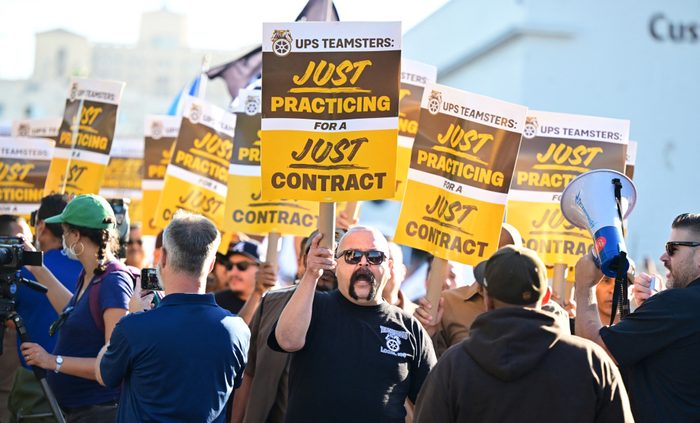
Among the complaints heard at Mendoza’s garage, however, is that the draw of the company’s health insurance is not enough to stem the loss of newly hired part-timers. “If we hire 10 new ones, half will be gone by the end of the month,” he says.
Either the part-time pay is too low, or the work is too physical, union officials say, explaining what they describe as a system-wide high turnover rate for these workers.
“Among part-timers within a month, if they hire 20 they will have only 3 workers left,” says Richard Hooker, secretary-treasurer of Local 623 in Philadelphia. A UPS spokesperson responds that 90,000 union-represented part-time employees have been with UPS for at least two years.
Back in Los Angeles, Mendoza recounts his short ride to the warehouse and how he gets ready for his job, leaving in the dark, early hours from the first-floor, two bedroom apartment where he lives with his partner and their son, her parents and brother.
He recites this mantra to himself:
I have a family. I have a son. It’s only a few hours. It will be over soon. I have to stay positive.
But that doesn’t work, either.
A former labor writer for the Chicago Tribune, Stephen Franklin is a Pulitzer Prize finalist and an adjunct professor at the University of Illinois Urbana-Champaign School of Labor and Employment Relations.

